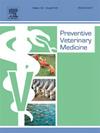埃塞俄比亚西北部贡德尔区两个地区小农奶牛场牛疱疹病毒 1 的血清流行率和相关风险因素。
IF 2.4
2区 农林科学
Q1 VETERINARY SCIENCES
引用次数: 0
摘要
牛疱疹病毒 1(BoHV-1)是引起牛传染性鼻气管炎(IBR)的传染源,这种疾病影响牛的生殖和呼吸系统。牛传染性鼻气管炎会造成严重的经济损失,因为它会导致牛患甲沟炎、流产、胎盘滞留、反复配种、动物死亡以及因贸易限制而造成的损失。埃塞俄比亚南部、西南部和饲养改良品种奶牛的主要城市都有关于牛鼻气管炎的报告,发病率为 28.5-67%。然而,关于IBR在该国西北部地区的发生率和传播情况,目前还没有足够的信息。我们在埃塞俄比亚西北部开展了一项横断面研究,以估计 BoHV-1 的血清流行率并确定相关风险因素。采用多阶段群组抽样技术选择奶牛场和农场主,采用简单随机抽样技术选择奶牛。从埃塞俄比亚西北部贡达尔区北部和中部的 Debark 和 Lay-Armachiho 地区的 177 个牧场中选取了 431 头奶牛提供血清样本。奶牛的主人通过调查问卷提供了相关信息。采用竞争性酶联免疫吸附试验(c-ELISA)检测血清样本中的抗 BoHV-1 抗体。为了确定风险因素,我们使用了单变量和多变量混合效应逻辑回归模型。我们计算出动物水平和畜群水平的血清阳性率分别为 72 %(95 % CI:64.9-78.4 %)和 85.7 %(95 % CI:79.8-90 %)。胎次与BoHV-1血清流行率有关;胎次越高的奶牛BoHV-1血清流行率越高。与人工授精相比,公牛交配[OR=3.13,(95 % CI:1.74-5.64)]与德巴克区[OR=2.73(95 % CI:1.63-4.57)]相比,莱-阿马奇霍区与BoHV-1血清流行率有关。该研究表明,BoHV-1 在埃塞俄比亚西北部贡达尔地区的大城市以外以及饲养当地品种奶牛的奶牛场中流行。这表明需要关注 BoHV-1 的预防和控制。本文章由计算机程序翻译,如有差异,请以英文原文为准。
Seroprevalence and associated risk factors of bovine herpesvirus 1 in smallholder dairy farms in two districts of Gondar zones, North-West Ethiopia
Bovine herpesvirus 1 (BoHV-1) is the infectious agent that causes infectious bovine rhinotracheitis (IBR), a disease affecting the reproductive and respiratory systems of cattle. Significant economic losses result from infectious bovine rhinotracheitis because of metritis, abortions, placenta retention, recurrent breeding, animal deaths, and losses from trade restrictions. Reports of the diseases have been made in southern, southwestern and in major cities that kept improved breed of dairy cows in Ethiopia with prevalence ranging from 28.5–67 %. However, there is insufficient information available regarding the frequency and spread of IBR in the northwest part of the nation. In northwest Ethiopia, a cross-sectional study was carried out to estimate seroprevalence of BoHV-1 and identify associated risk factors. Dairy farms and farm owners were chosen using a multistage cluster sampling technique, while dairy cattle were chosen using a simple random sample technique. Four hundred and thirty-one dairy cattle from 177 herds in the Debark and Lay-Armachiho districts in the North and Central Gondar zones, respectively, both in Northwestern Ethiopia, were selected to provide serum samples. Owners of dairy animals provided information via questionnaires. Using a competitive enzyme-linked immunosorbent assay (c-ELISA), anti-BoHV-1 antibodies were detected in serum samples. To identify risk factors, univariable and multivariable mixed effect logistic regression models were used. We calculated animal level and herd level seroprevalence of 72 % (95 % CI: 64.9–78.4 %) and 85.7 % (95 % CI: 79.8–90 %), respectively. Parity was associated with seroprevalence of BoHV-1; cows with higher parity had increased seroprevalence of BoHV-1. Bull mating [OR=3.13, (95 % CI: 1.74–5.64)] compared to AI and Debark district [OR=2.73 (95 % CI: 1.63–4.57)] compared to Lay-Armachiho district, were associated with seroprevalence of BoHV-1. The study had shown that BoHV-1 is circulating out of the major cities and also on dairy farms keeping local breeds of dairy cows in Gondar zones, North-West Ethiopia. This suggests need of attention in prevention and control of BoHV-1.
求助全文
通过发布文献求助,成功后即可免费获取论文全文。
去求助
来源期刊

Preventive veterinary medicine
农林科学-兽医学
CiteScore
5.60
自引率
7.70%
发文量
184
审稿时长
3 months
期刊介绍:
Preventive Veterinary Medicine is one of the leading international resources for scientific reports on animal health programs and preventive veterinary medicine. The journal follows the guidelines for standardizing and strengthening the reporting of biomedical research which are available from the CONSORT, MOOSE, PRISMA, REFLECT, STARD, and STROBE statements. The journal focuses on:
Epidemiology of health events relevant to domestic and wild animals;
Economic impacts of epidemic and endemic animal and zoonotic diseases;
Latest methods and approaches in veterinary epidemiology;
Disease and infection control or eradication measures;
The "One Health" concept and the relationships between veterinary medicine, human health, animal-production systems, and the environment;
Development of new techniques in surveillance systems and diagnosis;
Evaluation and control of diseases in animal populations.
 求助内容:
求助内容: 应助结果提醒方式:
应助结果提醒方式:


